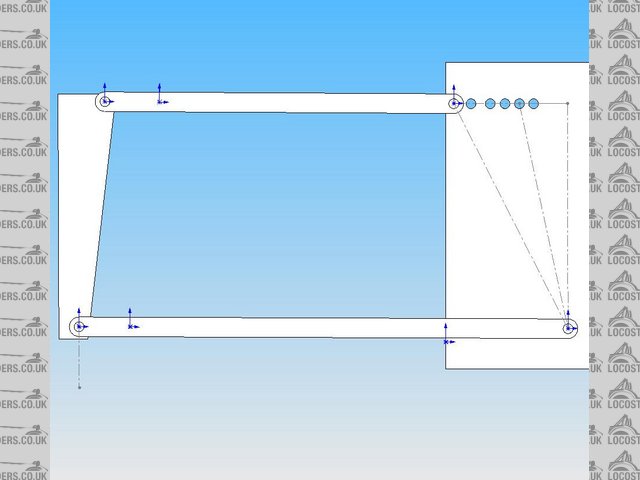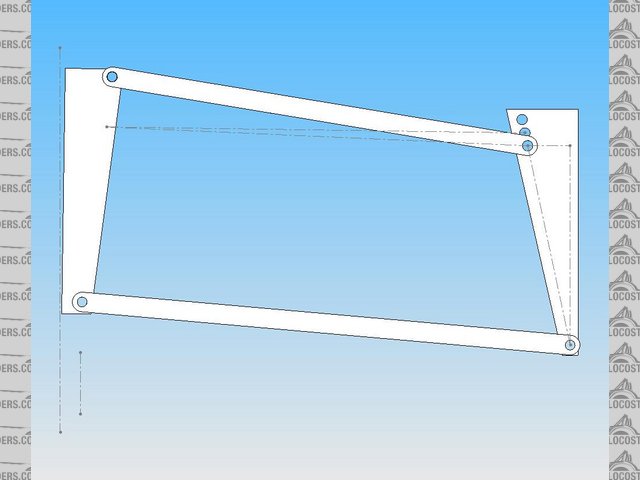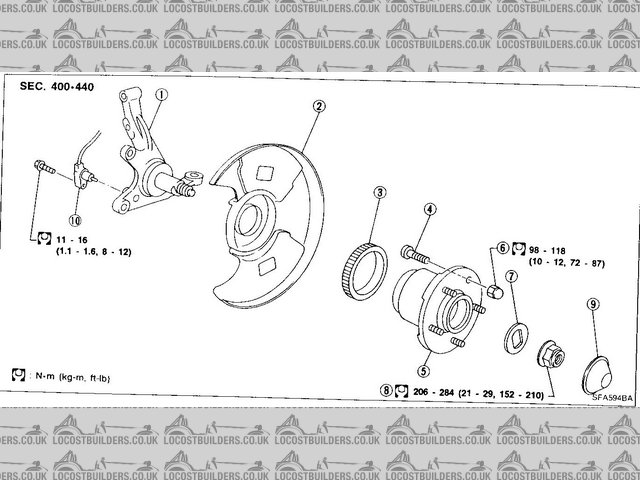Jesus-Ninja
|
| posted on 7/1/08 at 12:50 PM |

|
|
changes to camber and castor under compression.
I've got a copy of Allan Stanniforth's book winging it's way to me, but as I can't wait for it to arrive - here's a
question.
I know that it's a good thing to increase camber (relative to the vehicle) when the suspension is compressed on the outside wheel - hence the
shorter, relatively angled, upper arm. The degree to which camber increases is a matter for discussion I guess.
But am I right in saying that the introduction of more neg camber as the suspension compresses is correct?
What is the thought on changes in castor under compression of suspension? I know, now, that this is a "feature" of McPherson, pretty much
unavoidable as the strut which is comressing is the very thing which defines the castor.
I think....
Looking at 7-esque cars, the arms being mounted parallel axes, would suggest that, as the upper arm is shorter, any castor in the system is increased
under compression of the suspension, along with the camber.
Am I talkign out of my arse...?
If so, it wouldn't be for the first time! 
|
|
|
|
|
nitram38
|
| posted on 7/1/08 at 12:57 PM |

|
|
You are right about negative camber gain and as you said, the amount will be determined by the travel on your suspension.
Example, I have designed a car to be raised via air springs to vary the ride height from 3" to 6", so I have made mine with minimum
camber gain, otherwise I will get poor tyre wear.
As to castor, this should not change by much if the top and bottom bones are parrallel (un-equal A), but sometimes you might not have them parrallel
to stop anti-dive/anti squat.
Suspension is a compromise depending on the use of the car.
No straight forward answer, I'm afraid!
[Edited on 7/1/2008 by nitram38]
|
|
|
Jesus-Ninja
|
| posted on 7/1/08 at 02:28 PM |

|
|
Yup, I'm certainly finding that! The more I dig, the more I unearth!
But in essence, castor gain itself is not particularly something to be sought, as opposed to camber gain. Although caster gain may well be a by
product of the way the suspension is set up to control dive etc.
|
|
|
nitram38
|
| posted on 7/1/08 at 02:42 PM |

|
|
Castor mainly effects tyre scrub as you turn. The idea is that a line through the turning axis of the upright, intersects as close as possible the
centre of your tread patch.
If you aim for that, you will not be far out.
When castor is too far out, you tend only to notice this in tight turns at slow speeds. Your outside wheel will tend to be dragged around the corner
depending on how far the steering is turned.
If you are on a circuit where there are only small steering adjustments, you will hardly notice any castor changes, even if it is a fair bit out.
Don't go mad with camber gain either as it will have the oposite effect if you go too far.
By limiting your wishbone travel, you minimise drastic camber changes, hence the use of anti-rollbars.
You can design everything by the book and still have to change lots of settings afterwards,
I made some 2D wishbones in solidworks with varying lengths and pick up points so that I could measure the camber changes.
I recomment that you do the same, even if it is only out of some cardboard and thumbtacks (pivot points)
There are some examples in my archive under the ProjectX title:
 
wishbone test level
This picture shows exaggerated negative camber gain (remember your set up will not go this high!)
 
up
My recommendation is to start with your wheel and tyre to work out your top and bottom ball joint centres and your castor angle for your tyre patch
centre.
Once you have these, you will then be able to play around with wishbone lengths, pivots and angles.
[Edited on 7/1/2008 by nitram38]
|
|
|
Jesus-Ninja
|
| posted on 7/1/08 at 04:02 PM |

|
|
Great reply - thanks!
I'm modelling things in 3d studio. I want to use my existing hubs, which are on the end of McP struts. Fortunately the struts are not inserts,
but rather bolt on. I aim to make brackets with a ball joint arm on to take an upper arm, and then use the existing lower arm and tension arm (which
is adjustable for castor).
I'd have adjustable length on the upper arm for camber, and did consider making the points at which the A pivots on the body, adjustable in the
vertical, to enable aleration of the angle of the upper arm - to adjust camber gain.
|
|
|
Ians
|
| posted on 7/1/08 at 07:23 PM |

|
|
Is it not KPI that is the governing factor in scrub radius offset to minimise tyre scub in a turn...IanS
|
|
|
britishtrident
|
| posted on 7/1/08 at 08:18 PM |

|
|
The change in castor on a macpherson strut is a charactiersistic of the Macherson strut BUT it can be tailored. Ford saloon car racers of the
seventies lowered the the anti-rollbar mounting to introduce anti dive (Most Fords used the anti-roll bar as the brake reaction tie-rod.). You also
have the option of using a compression strut instead of a brake reaction tie-rod to take fore-aft reactions, this is a common mod on RWD Rally
Escorts.
Castor has absolutely no effect on tyre scrub in corners it has a big effect on the the loads through the steering wheel. Too much castor and the
steering loads up especially under high cornering loads and the car is tiring to drive. Too little castor and the steering lacks feel.
Be aware that kpi and castor are closely tied and also related to the effective camber when cornering.
If the KPI is X, then castor must be greater or equal to X.
[I] “ What use our work, Bennet, if we cannot care for those we love? .”
― From BBC TV/Amazon's Ripper Street.
[/I]
|
|
|
Jesus-Ninja
|
| posted on 7/1/08 at 08:38 PM |

|
|
KPI is the axis around which the wheel turns when steering, yes?
Excuse all the questions!
|
|
|
britishtrident
|
| posted on 7/1/08 at 08:47 PM |

|
|
quote:
Originally posted by Jesus-Ninja
KPI is the axis around which the wheel turns when steering, yes?
Excuse all the questions!
Yes the angle of the "king pin" when viewed from the front looking aft.
On most macpherson strut suspensionsl it is the same as the angle of the strut centreline .
Likewise castor is the angle of the macpherson viewed from the side.
[I] “ What use our work, Bennet, if we cannot care for those we love? .”
― From BBC TV/Amazon's Ripper Street.
[/I]
|
|
|
nitram38
|
| posted on 8/1/08 at 05:53 AM |

|
|
Sorry guys, I was typing before I was thinking!
KPI effects tyre scrub, castor affects centering!
|
|
|
t.j.
|
| posted on 8/1/08 at 07:34 AM |

|
|
How much KPI do the uprights we use here have then?
Would be great for all off us:
Ford:
Sierra:
Cortina/Taunus:
Vauxhall/Opel:
Chevette/Kadett
Manta/Ascona
Bmw:
e36
Toyota:
liteace
supra
Maybe someone have the info?
I'm moving from one house to the other so my books on Opel are lost some where.
But I think if the formula Castor > Kpi is important then it's needed to know what the KPI is
Please feel free to correct my bad English, i'm still learning. Your Dutch is awfull! :-)
|
|
|
Jesus-Ninja
|
| posted on 8/1/08 at 10:31 AM |

|
|
If I'm understanding this right, surely you can't just say that an upright has a certain KPI.
Have I understood it correctly that the KPI is measured relative to the vertical?
That would mean that the KPI is dependent on how you have the upright installed - ie the relative lengths of the upper and lower wishbones.
Having said that, I may have got this round my neck. If KPI is measured relative to camber, then yes, you could attibute a figure to a given
upright.
I think..... 
[Edited on 8/1/08 by Jesus-Ninja]
[Edited on 8/1/08 by Jesus-Ninja]
|
|
|
Syd Bridge
|
| posted on 8/1/08 at 10:43 AM |

|
|
quote:
Originally posted by britishtrident
If the KPI is X, then castor must be greater or equal to X.
Once again, NOT true!
Check most Mac strut cars. Geez, Sierras had 13+degrees of effective KPI, but only a few degrees of castor. Same with nearly all Mac struts setups.
Have a look at early 911's for some extreme numbers.
Cheers,
Syd.
[Edited on 8/1/08 by Syd Bridge]
|
|
|
nitram38
|
| posted on 8/1/08 at 11:17 AM |

|
|
I am afraid that if you use a manufacturers upright, then apart from putting an offset adapter in the Mcpherson strut top hole, you are stuck with the
kpi of their design.
I made my hubs by working out my kpi first based on the wheel I was going to use.
Wheel offset won't affect the kpi angle but it can affect where the kpi intersects the tread patch, so by altering the wheel offset, you can
still end up with the kpi intersecting where you want it.
|
|
|
Jesus-Ninja
|
| posted on 8/1/08 at 11:44 AM |

|
|
quote:
Originally posted by nitram38
I am afraid that if you use a manufacturers upright, then apart from putting an offset adapter in the Mcpherson strut top hole, you are stuck with the
kpi of their design.
My uprights don't have a "hole" for a strut. There's a flange with two holes in it, to which the strut bolts. But I take your
point. 
The strut actually lies well inboard from the place it bolts onto the upright, so my options may well be improved.
 
Rescued attachment upright.JPG
|
|
|













